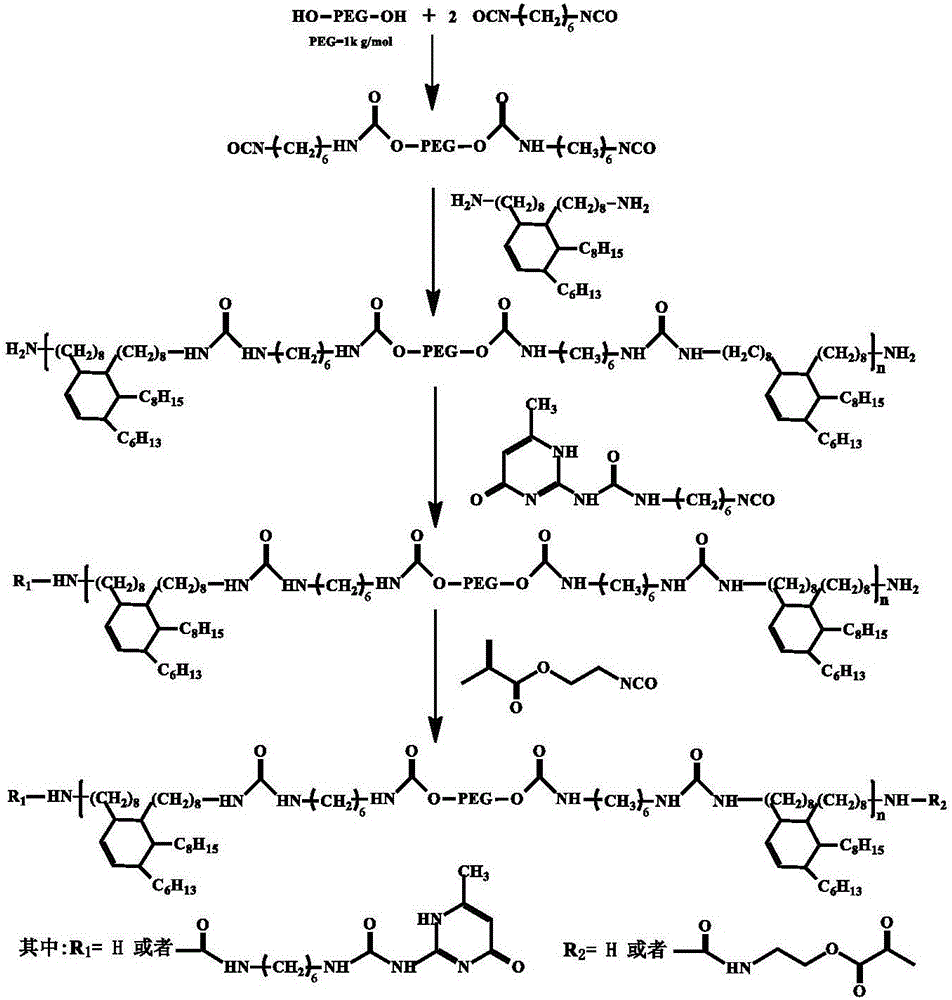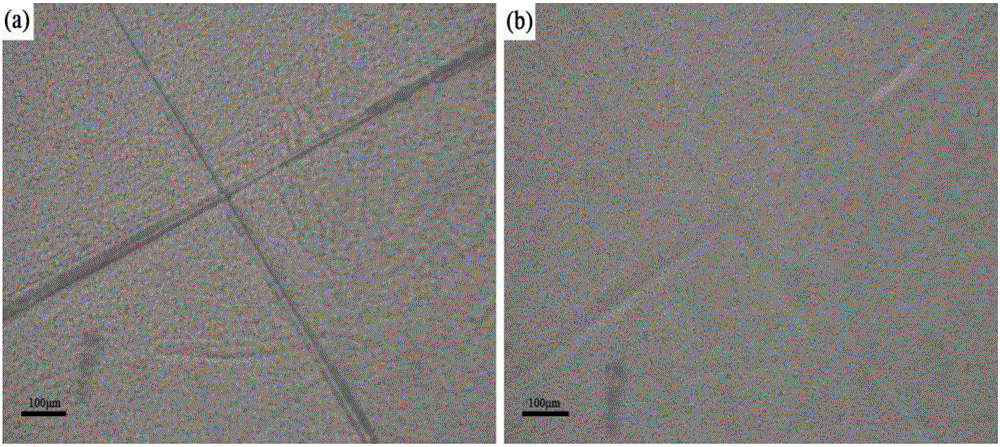Bio-based photosensitive polyurethane resin, and self-repairing coating made of resin
A polyurethane resin, bio-based dimeramine technology, used in polyurea/polyurethane coatings, coatings, etc., to achieve high curing efficiency, improve repair efficiency, and fast curing speed
- Summary
- Abstract
- Description
- Claims
- Application Information
AI Technical Summary
Problems solved by technology
Method used
Image
Examples
Embodiment 1
[0029] (1) Synthesis of bio-based photosensitive polyurethane resin: First, add 50.000g PEG-1000, 0.401g dilauric acid di Butyltin and 60g of anhydrous chloroform were stirred to form a clear solution; at the same time, a mixture of 16.820g of hexamethylene diisocyanate and 30g of anhydrous chloroform was slowly added dropwise to the flask, and reacted at 50°C for 7h. Continue to drop 31.980 g of Priamine 1074 and 40 g of anhydrous chloroform mixture, and react at 25° C. for 6 h to obtain a bio-based polyurethane solution with an amino terminal. Secondly, a mixture of 4.786g UPy-NCO and 100g anhydrous chloroform was slowly added dropwise, and the reaction was kept at 25°C for 6h to obtain a self-healing bio-based polyurethane solution. Finally, slowly drop a mixture of 4.655g isocyanoethyl methacrylate, 0.093g hydroquinone, and 30g anhydrous chloroform, keep the reaction at 30°C for 6 hours, and rotate to evaporate the excess chloroform solution , to obtain a bio-based photos...
Embodiment 2
[0032](1) Synthesis of bio-based photosensitive polyurethane resin: First, add 50.000g PEG-1000, 0.401g dilauric acid di Butyltin and 60g of anhydrous chloroform were stirred to form a clear solution; at the same time, a mixture of 16.820g of hexamethylene diisocyanate and 30g of anhydrous chloroform was slowly added dropwise to the flask, and reacted at 50°C for 7h. Continue to drop 31.980 g of Priamine 1074 and 40 g of anhydrous chloroform mixture, and react at 25° C. for 6 h to obtain a bio-based polyurethane solution with an amino terminal. Secondly, a mixture of 5.983g UPy-NCO and 120g anhydrous chloroform was slowly added dropwise, and kept for 6 hours at 25°C to obtain a self-healing bio-based polyurethane solution. Finally, slowly drop a mixture of 3.879g of isocyanoethyl methacrylate, 0.093g of hydroquinone, and 25g of anhydrous chloroform, keep the reaction at 30°C for 6 hours, and rotate to evaporate the excess chloroform , to obtain a bio-based photosensitive poly...
Embodiment 3
[0036] (1) Synthesis of bio-based photosensitive polyurethane resin: First, add 50.000g PEG-1000, 0.401g dilauric acid di Butyltin and 60g of anhydrous chloroform were stirred to form a clear solution; at the same time, a mixture of 16.820g of hexamethylene diisocyanate and 30g of anhydrous chloroform was slowly added dropwise to the flask, and reacted at 50°C for 7h. Continue to drop 31.980 g of Priamine 1074 and 40 g of anhydrous chloroform mixture, and react at 25° C. for 6 h to obtain a bio-based polyurethane solution with an amino terminal. Secondly, a mixture of 7.179g of UPy-NCO and 140g of anhydrous chloroform was slowly added dropwise, and kept for 6 hours at 25°C to obtain a self-healing bio-based polyurethane solution. Finally, slowly drop a mixture of 3.103g isocyanoethyl methacrylate, 0.093g hydroquinone, and 20g anhydrous chloroform, keep the reaction at 30°C for 6 hours, and rotate to evaporate the excess chloroform solution , to obtain a bio-based photosensiti...
PUM
 Login to view more
Login to view more Abstract
Description
Claims
Application Information
 Login to view more
Login to view more - R&D Engineer
- R&D Manager
- IP Professional
- Industry Leading Data Capabilities
- Powerful AI technology
- Patent DNA Extraction
Browse by: Latest US Patents, China's latest patents, Technical Efficacy Thesaurus, Application Domain, Technology Topic.
© 2024 PatSnap. All rights reserved.Legal|Privacy policy|Modern Slavery Act Transparency Statement|Sitemap


